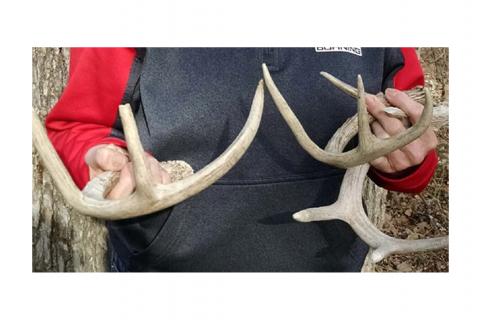
By Tom Nelson
The still frozen ground crunched beneath my feet as I walked yet another heavily used deer trail beat down with hoofed tracks. The early March weather was typical for Michigan with the mercury hoovering in the low 40’s and overcast. The cedar swamp I was traversing with its heavy canopy, insulated the ground, keeping most everything, frozen solid given the temperature. For my wife and I, it was perfect conditions for shed hunting.

Check them out right here!
I still recall the first shed I ever stumbled upon. It was early spring and I was doing a bit of turkey scouting in mid-April. It had been a late spring and patches of snow still lingered in the nearby woodlots and ditches. I was ambling along the edge of grass field looking for a place to cross the fence the separated the grass field from a small woodlot. Spotting a low spot in the fence I went to cross it there. As I started to swing my leg over the fence, I spied an antler laying just on the other side of the fence. I hurried across the fence and grabbed onto the forked antler. I was elated with my prize and could not wait to show my bowhunting friends my find.
Finding that dropped forked horn antler some 30 plus years ago, turned me into a fanatical spring time shed hunter. While I still love to hunt turkeys each spring, I must confess I get just as excited over the prospect of going out shed hunting as I do Michigan’s bearded birds about. Over the years I have introduced my wife Beth into the art of shed hunting and she has embraced the activity fully. After a long winter there is no better cure for cabin fever than to get out and spend a day in the woods and fields searching for cast off antlers.
The majority of whitetail bucks cast or shed their antlers during the months of January and February. Whitetail bucks in poor health tend to cast their antlers early while healthy bucks will hold onto theirs longer. The severity of Michigan’s winters tend to have an impact on when bucks shed also. Mild winters you may see bucks carrying their antlers well into late March or on rare occasions early April. During the spring of 2016, while shed hunting, Beth and I both observed an antlered buck on the 7th of April. He still was holding onto both sides of his 3x3 rack. On the other side of the coin, I have personally witnessed bucks in late December that had lost one or both sides of their antlers.
The month of March and early April is my favorite time for shed hunting. The landscape is easy to navigate and deer trails are highly visible. We look for tell tale signs of deer activity, such as well traveled deer trails. Trails that lead from bedding to feeding areas. We slowly walk these trails scanning the sides as well as the trail in front of us when searching. Crossings such as a fence, ditch or creek are hot spots for locating cast off antlers. As a buck jumps over an obstacle, the jolt of his landing often is all that is needed to cause an antler to fall off. Crossing that we have found sheds in the past are often places we will find them again.
Bedding areas are another excellent place to search for shed antlers. Bedded bucks tend to do a good bit of head shaking and rubbing in their bedding areas. These areas are normally thick nasty areas were whitetails feel secure. Getting in and out of these bedding areas can prove difficult at times for shed hunters but the rewards can be well worth the effort.
My wife Beth and I always make our shed hunting a little competitive. We definitely keep track of who finds the most sheds and who finds the largest. One particular day this past March, Beth put me to shame as she found 4 nice sheds. Me, I was skunked and she reminded me of the fact all the way home that late afternoon.
Winter food sources that deer frequented during the winter months are another key location for shed hunting. Grain fields that wintering deer on a regular basis are spots that bucks tend to leave cast off antlers. Big fields can be tough to search but also well worth the time spent doing so. We concentrate on smaller food plots and the trails leading to and from them. Doing so we have had good success finding sheds. Trust me when I tell you that any farmer will be pleased to find out you picked up a potential tire flattener when you relocate a shed antler from his field. This is a good time to note that it is far easier to gain permission to shed hunt than it is to get permission to hunt. Keep in mind however this is a great way to get your foot in the door and start a relationship with the land owner.
For my wife and I, shed hunting is a great way to enjoy the outdoors and also to get a little post season scouting done. After the winter snow is gone or nearly gone, the landscape pretty much looks exactly as it did last fall. Scrapes, rubs and deer travel routes are still highly visible. Areas that I would not normally venture into for fear of spooking whitetails are now far game. Shed antlers that are found give us a good idea as to who and what survived the previous hunting season as well and the winter. Our greatest pleasure however is the time spent in the woods and fields in our quest to find shed antlers.
- 2411 views

